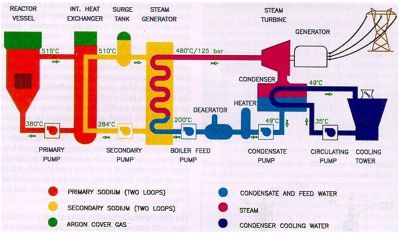Context
India's nuclear program has long been a focal point of its energy strategy, aiming for self-sufficiency and sustainability. Prime Minister Narendra Modi's recent involvement in the core-loading event of the Prototype Fast Breeder Reactor (PFBR) at Kalpakkam signifies a significant milestone in this endeavor. The PFBR, an integral component of India's three-stage nuclear power program, holds promise in revolutionizing the country's energy landscape. Despite its potential, the PFBR project has faced numerous challenges, including delays, cost overruns, and technical setbacks. Understanding the significance of the PFBR and its implications for India's energy future requires delving into its design, operational mechanism, and the hurdles it has encountered.
The Significance of PFBR Core-Loading Event
The core-loading event of the PFBR stands as a pivotal moment in India's nuclear trajectory due to its role in advancing the country's three-stage nuclear power program. Unlike traditional reactors, the PFBR operates as a breeder reactor, generating more nuclear fuel than it consumes. This capability is essential for sustaining India's long-term nuclear energy objectives, particularly in light of the country's vast thorium reserves. The initiation of core-loading symbolizes the transition into stage II of India's nuclear program, marking a significant step towards achieving energy self-sufficiency.
Furthermore, the PFBR's success holds broader implications for India's energy security and environmental sustainability. By harnessing indigenous nuclear technology, India can reduce its reliance on fossil fuels and mitigate the adverse effects of climate change. Additionally, the operationalization of the PFBR underscores India's technological prowess and its commitment to harnessing nuclear energy for peaceful purposes. Despite the challenges and setbacks faced by the PFBR project, its core-loading event represents a triumph of scientific ingenuity and perseverance.
Understanding the Prototype Fast Breeder Reactor (PFBR)
The PFBR represents a paradigm shift in nuclear reactor design, leveraging fast breeder technology to maximize fuel efficiency and production. Unlike conventional reactors, which utilize enriched uranium as fuel, the PFBR employs a combination of plutonium-239 (Pu-239) and uranium-238 (U-238) to sustain a self-sustaining chain reaction. This innovative approach not only extends the lifespan of nuclear fuel but also facilitates the production of additional fissile material, such as U-233, essential for future reactor cycles.
Moreover, the PFBR's utilization of liquid sodium as a coolant further enhances its efficiency and performance. Liquid sodium's excellent heat transfer properties enable the reactor to operate at higher temperatures, optimizing energy production while minimizing waste. Additionally, the PFBR's breeder blanket design ensures the continuous replenishment of fissile material, enabling sustained energy generation over extended periods. Despite its complexity, the PFBR holds immense potential in revolutionizing India's nuclear energy landscape and advancing the country's energy security objectives.
The Delays and Challenges
Despite its potential, the PFBR project has encountered numerous delays and challenges, hindering its timely operationalization. The project's inception dates back to the early 2000s, with ambitious timelines and cost estimates set by the Department of Atomic Energy (DAE). However, technical complexities, regulatory hurdles, and unforeseen setbacks have plagued the project, leading to significant delays and cost overruns.
One of the primary reasons for the PFBR's delayed timeline was the technical difficulties associated with its design and construction. The intricate nature of breeder reactor technology, coupled with the need for specialized materials and components, posed formidable challenges for project execution. Additionally, regulatory scrutiny and safety concerns further contributed to the project's prolonged timeline, necessitating extensive testing and validation procedures.
Furthermore, the PFBR project faced financial constraints and funding shortages, exacerbating delays and impeding progress. The escalating costs and budgetary allocations required frequent revisions and extensions, straining the project's resources and viability. Moreover, organizational inefficiencies and bureaucratic hurdles within the DAE and its affiliated agencies further compounded the project's challenges, leading to delays and mismanagement.
The Role of Small Modular Reactors (SMRs)
Amidst the challenges encountered by the PFBR project, the emergence of Small Modular Reactors (SMRs) presents an alternative approach to nuclear energy deployment. SMRs offer several advantages over conventional reactor designs, including enhanced safety features, reduced construction costs, and modular scalability. These compact reactors can be deployed in diverse settings, including remote areas and existing industrial facilities, offering flexibility and adaptability in energy production.
Moreover, SMRs utilize low-enriched uranium fuel, which enhances proliferation resistance and reduces security risks associated with nuclear fuel handling. This characteristic makes SMRs particularly attractive for countries seeking to expand their nuclear energy capacity while mitigating geopolitical concerns. Additionally, SMRs can complement existing energy infrastructure and facilitate the transition towards a low-carbon energy future.
However, the widespread adoption of SMRs necessitates regulatory reforms and policy interventions to address legal and institutional barriers. Amendments to existing nuclear legislation, such as the Atomic Energy Act, are essential to accommodate private sector participation and international collaboration in SMR deployment. Furthermore, regulatory frameworks must ensure safety standards, nuclear security, and non-proliferation safeguards to mitigate potential risks associated with SMR proliferation.
Conclusion
The core-loading event of the Prototype Fast Breeder Reactor (PFBR) represents a watershed moment in India's nuclear energy journey, marking the fruition of decades of research, development, and perseverance. Despite the challenges and setbacks encountered along the way, the PFBR stands as a testament to India's technological prowess and commitment to harnessing nuclear energy for sustainable development. As India transitions into stage II of its three-stage nuclear power program, the PFBR's operationalization holds immense promise in advancing the country's energy security objectives and reducing its reliance on fossil fuels.
Moving forward, India must address the underlying challenges and bottlenecks that have hindered the PFBR project's progress, including regulatory reforms, funding constraints, and organizational inefficiencies. Moreover, the emergence of Small Modular Reactors (SMRs) presents new opportunities for enhancing India's nuclear energy capacity and diversifying its energy portfolio. By embracing innovation, collaboration, and strategic planning, India can realize its vision of a robust and sustainable nuclear energy sector, contributing to economic growth, environmental stewardship, and energy security for future generations.
|
Probable Questions for UPSC Mains Exam
|
Source – The Hindu







